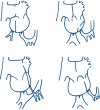The Fontan circulation
- PMID: 15894794
- PMCID: PMC1768934
- DOI: 10.1136/hrt.2004.051789
The Fontan circulation
Figures



References
-
- Gewillig M, Kalis N. Pathophysiologic aspects after cavo-pulmonary anastomosis. Thorac Cardiovasc Surg 2000;48:336–41. ▸ Extensive review of the effects of different pre-Fontan treatment strategies on ventricular size and function. - PubMed
-
- Choussat A, Fontan F, Besse F, et al. Selection criteria for Fontan’s procedure. In: Anderson R, Shinebourne E, eds. Paediatric cardiology. Edinburgh: Churchill Livingstone, 1978:559–66.
-
- De Leval M, Kilner P, Gewillig M, et al. Total cavopulmonary connection: a logical alternative to atriopulmonary connection for complex Fontan operations. Experimental studies and early clinical experience. J Thorac Cardiovasc Surg 1988;96:682–95. ▸ Elegant discussion on advantages of cavopulmonary connections versus atriopulmonary connection. - PubMed
-
- Bridges ND, Lock JE, Castaneda AR. Baffle fenestration with subsequent transcatheter closure. Modification of the Fontan operation for patients at increased risk. Circulation 1990;82:1681–9. - PubMed
Publication types
MeSH terms
LinkOut - more resources
Full Text Sources
Other Literature Sources
Medical
